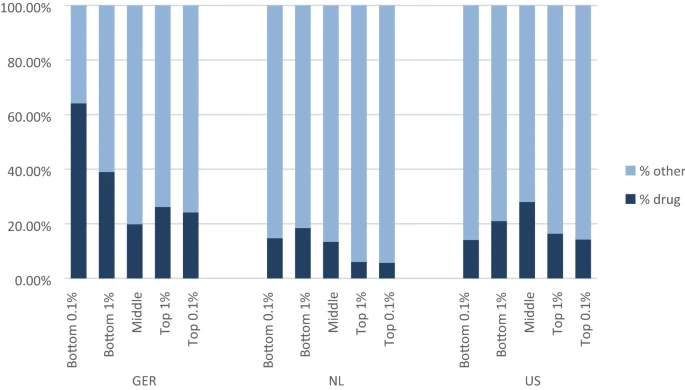Informe de Salut de Catalunya 2011
Quan Geofrey Rose va escriure el seu article fonamental en epidemiologia -
Sick individuals and sick populations - en realitat estava destriant quin ha de ser el fonament de les polítiques de la salut pública i les paradoxes que l'envolten. Al resum deia que l'origen de les malalties s'enfronta a dues qüestions, els determinants dels casos individuals, i els determinants de la taxa d'incidència:
If exposure to a necessary agent is homogeneous within a population, then case/control and cohort methods will fail to detect it: they will only identify markers of susceptibility. The corresponding strategies in control are the 'high-risk' approach, which seeks to protect susceptible individuals, and the population approach, which seeks to control the causes of incidence. The two approaches are not usually in competition, but the prior concern should always be to discover and control the causes of incidence.
Això que s'escrivia el 1985 segueix sent d'interès, malgrat els necessaris
matisos fruit de l'evolució del coneixement. Tot mirant l'informe sobre
la salut dels catalans, veig que el 60% de les causes de la mortalitat evitable són susceptibles d'actuació mitjançant polítiques sanitàries intersectorials, mentre que el 40% seria per part dels serveis de salut. Caldria pensar doncs en l'estratègia poblacional de Rose en primer lloc si volem reduir més la mortalitat evitable que representa el 13,6% de les defuncions (16,2 H, 9,8 D). Hem d'estar satisfets que hagi disminuït un 14% entre 2005 i 2009, però cal restar amatents (p.105). Aquesta dada també incorpora una reducció de mortalitat per accidents de trànsit, 40% en cinc anys, i en certa mesura caldria ajustar-la per l'exposició al risc, que previsiblement ha disminuït amb la crisi.
Si voleu fer una ullada a les tendències de l'esperança de vida a Europa, mireu al
IJE. Curiosament a l'informe que comento no es mostren aquest tipus de dades. S'en deuen haver oblidat.
PS. Reprodueixo
el manifest del col·lectiu EMMA i m'hi adhereixo
What's really going on in Catalonia (Notes on the present financial crisis in Spain and the political options for Catalans)
A full-fledged bailout of Spain is now taken for granted by most observers. In the meantime, Mr. Rajoy's government has grudgingly agreed to submit its finances to external oversight and to implement some overdue reforms. It is unlikely, however, that the measures it has taken can actually put the country's economy on the right track. So far, they seem to be designed to raise money for the state's operation rather than to stimulate growth and create jobs. And while the need for austerity is unquestionable, there are serious doubts about the focus of the spending cuts and about the selective way in which they are applied. In fact, the central government is passing much of the pain on to the regional and local administrations, which are responsible for the provision of most basic services. We are already witnessing the damaging effect of those policies on the lives of citizens and some foreseeable angry reactions.
At first glance, and given the regions' histories of carefree spending while times were good, efforts to rein them in might seem reasonable. We shouldn't forget, however, that the central government itself has been just as guilty of wastefulness and poor management, and that it's still refusing to give up some very expensive and very questionable programs. Also, restrictions are imposed across the board, making no distinction between the communities that rely on their own money to pay for the services they provide and those that are essentially living –quite regally in some cases– on public funds that the central government has extracted from the former. And no regard is given to whether or not individual regional administrations have been acting to control their budgets and to put their house in order, or to how well they're doing on that count.
Admittedly, Catalonia's record in the making of today's crisis is not brilliant. Like other southern European societies, it got used to living beyond its means. The real estate boom, encouraged by cheap credit and slack financial and political supervision, created the illusion of riches that is at the root of the present troubles. At the same time, the irresponsible policies of previous regional administrations have left a poisonous legacy of public debt. Catalans have brought upon themselves much of their hardship, but their economy remains strong enough to overcome the situation, and their burden of public and private debt would be manageable in the short to medium term if Catalonia had full use of the revenue it generates.
But today we are facing a grotesque situation in which the central government –a net recipient of Catalan resources– threatens with intervention a community that was the first to implement painful austerity measures and whose economy, if given a chance to develop, could best ensure the state's economic viability. Indeed, long before Mr. Rajoy was finally compelled to act by the country's EU overseers, the Catalan administration under President Artur Mas had set out implementing an unpopular policy of fiscal adjustment. Now it is being asked by the central government to inflict on its citizens one more round of cuts that jeopardize not only the provision of services but also most productive investments in infrastructures, education or research that are essential for any society's future. In fact, the central government is demanding of Catalonia sacrifices that it wouldn't dream of imposing on itself.
***
Mr. Mas now finds his government's every move constrained by the dire need of financing for its day-to-day operation, while the necessary funds can be released or withheld by the central government essentially at its discretion. So far he has chosen to treat this as a strictly financial problem and, following this line, he's trying to reach with the other political parties in Catalonia a consensus position that could be a basis to renegotiate the fiscal relationship between Catalonia and the Spanish central government. However, some Catalan officials will admit in private that, even if that consensus could be found at home, the chances of an agreement with Madrid are almost nil. As long as the continuity of the Spanish project depends on the funds obtained from Catalonia, the central government can hardly afford to give Catalans a just financial deal without endangering the very survival of the state.
The ruling coalition would like to keep all its options open, but as things now stand Mr. Mas may well be running out of them. Essentially, he can insist on a negotiation and try to wring from the Spanish government some sort of compromise, even if he's aware that all he can expect is just another bad deal that would only postpone the inevitable showdown. Or he could go for a clean break with a state that doesn't feel it needs to sit and talk with a province that it can control absolutely as long as it holds the purse strings.
On the home front, influential players in the economic scene are reluctant to go along with any steps that could lead to a major confrontation with Spain. This is also the position taken by representatives of unionist parties in Catalonia, who insist on preserving the status quo even if it's clearly damaging for their constituents. No wonder this approach has made them lose support in every election.
On the other hand, a clean break is exactly what a large body of Catalans –civil society organizations, local councils, the rank-and-file of various parties and a growing number of private individuals– appears to be demanding from its leaders. The latest polls show support for independence at over fifty per cent, while the numbers of those squarely opposing it –now around twenty-one percent– continue to fall.
Understandably, economic grievances are cited by many of the Catalans who have been warming up to the idea of independence in the past few months. When citizens are being subjected to service cuts and tax hikes while a big chunk of the revenue they generate continues to be siphoned off by the central government, the economy would be a good enough reason for Catalans to give some serious thought to political separation from a state that is clearly working against their interests.
But it would be wrong to characterize this as a mere financial dispute between a province and its capital. There is a more fundamental disagreement, which is of a political nature and whose solution would imply a complete redefinition of the state that no one outside of Catalonia is even ready to consider. These deeper problems will be impossible to solve as long as Spain refuses to acknowledge the existence within the state of very diverse societies with conflicting sets of values and to revise some tenets that it regards as essential to its national being.
***
For a growing number of Catalans, Spain is a dead-end road, incapable of healing itself and offering them no perspectives except more of the same old systematic plunder of their hard-earned resources at the same time that it uses every opportunity to stamp out their national character. And they see the only way out in a peaceful, orderly and responsible process of political independence.
There are justified concerns, domestically and internationally, over the can of worms that a process of independence could open. Independence can indeed be messy, and today Europe and the world may think that they can ill afford an open conflict and an added source of instability. And yet, conflict is what has defined the relation between Catalonia and Spain for at least three hundred years, and instability –a systemic, unsolvable form of instability– is what we already have there. Conversely, the emergence of Catalonia as a solid political reality, creditworthy and ready to face up to its international obligations, would surely become a source of stability in the south of Europe.
As a result of the financial crisis, many outside observers have become aware of Spain's economic and political shortcomings, and some may now begin to see Catalonia as what it is –a viable and active community that is being made to pay for the incurable flaws of a political project that for three hundred years has been incapable of building a cohesive project for its constituent peoples.
Beyond their immediate difficulties, Catalans are now calling for a brand new long-term political project allowing the survival of an economic, social and cultural model that, in spite of all the obstacles and shortcomings, both external and self-imposed, has succeeded in building a relatively prosperous, creative and inclusive society.
In Catalonia today the people are well ahead of their government. They expect from their leadership that it takes on its responsibilities towards the present and future generations. If their government chooses to heed this call and throw its weight behind them, many more will come round. If it doesn't, Catalans are likely to forge ahead no matter what, either by their government's side or marching in front of it to show the only way to a better future.
These notes were prepared by Col·lectiu Emma and have the endorsement of a number of respected civil society representatives.
Alícia Adserà (Princeton University), Sebastià Alzamora (writer), Carles Boix (Princeton University), David Boronat (entrepreneur), Enric Bou (Università Ca' Foscari Venezia), Jaume Cabré (writer), Miquel Calçada (journalist and businessman), Salvador Cardús (Universitat Autònoma de Barcelona), Ramon Carner (Cercle Català de Negocis), Muriel Casals (Universitat Autònoma de Barcelona), Àngel Castiñeira (ESADE), Liz Castro (writer), Jordi Comas (architect), Xavier Cuadras (Universitat Pompeu Fabra), Jordi Cuixart (businessman), Ramon Folch (businessman), Jordi Galí (Universitat Pompeu Fabra), M Dolors Genovés (journalist and historian), Josep Ginebra (Universitat Politècnica de Catalunya), Modest Guinjoan (Universitat Pompeu Fabra), Jaume López (Universitat Pompeu Fabra), Josep Maria Lozano (ESADE), Isidor Marí (Universitat Oberta de Catalunya), Isabel-Helena Martí (businesswoman), Rita Marzoa (journalist), Francesc Mortés (businessman), Ferran Requejo (Universitat Pompeu Fabra), Joan Ramon Resina (Stanford University), Xavier Roig (writer and engineer), Jaume Soler (accoustician), Miquel Strubell (Universitat Oberta de Catalunya), Àlex Susanna (writer), Quim Torra (editor), Jordi Torras (entrepreneur), Matthew Tree (writer), Ramon Tremosa (MEP, Universitat de Barcelona), Jaume Vallcorba (Fundació Catalunya Estat), Jaume Ventura (Universitat Pompeu Fabra).
Endorsement's update: Update: Germà Bel (Universitat de Barcelona), Martí Boada (Universitat Autònoma de Barcelona), Susan Digiacomo (Universitat Rovira i Virgili), Josep Gifreu (Universitat Pompeu Fabra), Josep Maria Figueres (Universitat Autònoma de Barcelona), Jordi Graupera (journalist), Antoni Maria Piqué (journalist)









